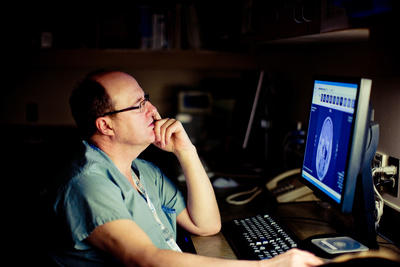July 13, 2015
Neurosurgeon receives third honour from NASA for Project neuroArm

neuroArm made history in 2008 when the robotic system was used on a human for the first time.
University of Calgary
Dr. Garnette Sutherland, neurosurgeon, University of Calgary professor and founding director of the Seaman Family MR Research Centre, is being honoured with a prestigious NASA Exceptional Technology Achievement Medal in recognition of his work with Project neuroArm.
The world’s first MRI-compatible surgical robot neuroArm became part of innovation history in 2008 when it was used to remove a brain tumour from 21-year-old Paige Nickason — the first such operation involving a human patient.
Sutherland, a member of the Hotchkiss Brain Institute, previously developed the intraoperative MRI machine with the National Research Council in Winnipeg. The technology allows a high field MRI scanner to move into the operating room on demand. Linked to this technology, neuroArm, an image-guided MR compatible neurosurgical robot evolved. The robotic arms are controlled by a surgeon at a remote workstation. This allows the operator to perform precision microsurgery with the benefit of near real-time imaging, a 3D surgical field, enhanced acoustics through headsets for communication and a haptic (tactile) sensor technology for touch.
The neuroArm system is the result of applying robotic technologies developed for the CanadARM-2 and Dextre on the International Space Station (ISS) to improving surgical robotics here on Earth.
neuroArm-derived technologies include KidsArm and autonomous robot
This latest NASA honour, Sutherland’s third, recognizes his contributions to developing the neuroArm technology. The award further acknowledges the significance of that contribution to additional neuroArm-derived technologies, including the KidsArm, a smaller version of the neuroArm, and the Image-guided Autonomous Robot being developed by the Centre for Surgical Invention and Innovation in Ontario to provide a more accurate and less invasive identification and removal of breast tumours.
“As children, we all wonder at the stars and, as we grow, tend to follow the updates and progresses of NASA,” says Sutherland. “NASA, after all, put man on the moon. To be recognized by such an agency is obviously humbling but, at the same time, highly motivating to follow one’s dreams.
“For someone from the university medical program, this is a tremendous achievement not only for me, but also for our university, collaborators, industrial partners and, in particular, our community.”

Dr. Garnette Sutherland was named a Member of the Order of Canada in 2012.
University of Calgary
New project targets surgery at the cellular level
These derived technologies represent another step in the evolution of Project neuroArm. In collaboration with Matthias Amrein, director of the university’s Microscopy and Imaging Facility, Sutherland is now focusing on a new project called CellArm. It is a robotic system for cell interrogation and manipulation. The system is relevant to surgery as it shifts from the organ to a cellular level.
For his role in the development of neuroArm and his lifetime achievements in the field of medical innovation, Sutherland was named a Member of the Order of Canada in 2012. He is a professor in the Cumming School of Medicine’s Department of Clinical Neurosciences and an adjunct professor in the Faculty of Science.
The NASA Exceptional Technology Achievement Medal is awarded to government or non-government individuals for exceptional technology contributions achieved in one or more of the following: technology development significantly contributing toward achievement of the NASA mission; development of a broadly applicable, disruptive technology for advancing future research capabilities or commercial applications; development of key conceptual or theoretical advances to technology that significantly accelerate the achievement of NASA's mission; exemplary collaborative effort in achieving significant technology transfer or technology infusion; exceptional utilization of a NASA-developed technology resulting in a significant commercial application.
